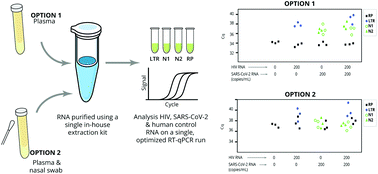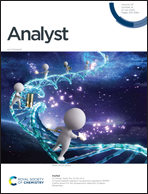Simultaneous monitoring of HIV viral load and screening of SARS-CoV-2 employing a low-cost RT-qPCR test workflow†
Abstract
The COVID-19 pandemic interrupted routine care for individuals living with HIV, putting them at risk of virologic failure and HIV-associated illness. Often this population is at high risk for exposure to SARS-CoV-2 infection, and once infected, for severe disease. Therefore, close monitoring of HIV plasma viral load (VL) and screening for SARS-CoV-2 infection are needed. We developed a non-proprietary method to isolate RNA from plasma, nasal secretions (NS), or both. The extracted RNA is then submitted to RT-qPCR to estimate the VL and classify HIV/SARS-CoV-2 status (i.e., HIV virologic failure or suppressed; SARS-CoV-2 as positive, presumptive positive, negative, or indeterminate). In contrived samples, the in-house RNA extraction workflow achieved a detection limit of 200-copies per mL for HIV RNA in plasma and 100-copies per mL for SARS-CoV-2 RNA in NS. Similar detection limits were observed for HIV and SARS-CoV-2 in pooled plasma/NS contrived samples. When comparing in-house with standard extraction methods, we found high agreement (>0.91) between input and measured RNA copies for HIV LTR in contrived plasma; SARS-CoV-2 N1/N2 in contrived NS; and LTR, N1, and N2 in pooled plasma/NS samples. We further evaluated this workflow on 133 clinical specimens: 40 plasma specimens (30 HIV-positive), 67 NS specimens (31 SARS-CoV-2-positive), and 26 combined plasma/NS specimens (26 HIV-positive with 10 SARS-CoV-2-positive), and compared the results obtained using the in-house RNA extraction to those using a commercial kit (standard extraction method). The in-house extraction and standard extraction of clinical specimens were positively correlated: plasma HIV VL (R2 of 0.81) and NS SARS-CoV-2 VL (R2 of 0.95 and 0.99 for N1 and N2 genes, respectively); and pooled plasma/NS HIV VL (R2 of 0.71) and SARS-CoV-2 VL (R2 of 1 both for N1 and N2 genes). Our low-cost molecular test workflow ($1.85 per pooled sample extraction) for HIV RNA and SARS-CoV-2 RNA could serve as an alternative to current standard assays ($12 per pooled sample extraction) for laboratories in low-resource settings.



 Please wait while we load your content...
Please wait while we load your content...